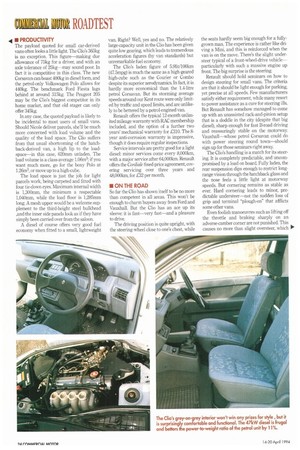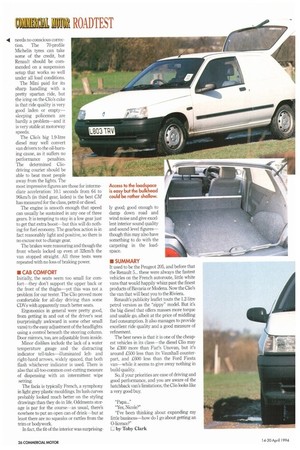ikCIZ LUIZ
Page 29

Page 30

Page 32

If you've noticed an error in this article please click here to report it so we can fix it.
Hatchback vans combine some of the best-and worst-features of a car and a van. Renault chose to fit a small van with a big diesel. Has it found the right formula?
"Papa..."
"Yes, Nicole?"
"I'm bored with flouncing around in new clothes. I want to start a business. Courier work, light deliveries, stuff like that. I suppose I'll need a van. What sort should I buy?"
"I may have just the thing..."
It has been a while since Renault had a vehicle at the entry level of the commercial market. Its Extra high-cube van, using the 5's front end, holds a secure place in its sector—and has helped to create the enormous market for high-cube vans on the Continent. But it has held on for some time before coming out with the van version of the successful Clio.
Renault must be hoping it has not waited too long. The Clio's launch coincides with the appearance of Vauxhall's Corsavan, Ford's revamped (and repriced) Fiesta and Escort ranges and the re-engined, cheaper Volkswagen Golf van.
The loyal French market may be a pushover—unless Peugeot comes up with a 106 van—but in the rest of Europe, a new contender has to stand out one way or another. • PRODUCT PROFILE There is nothing remarkable about Renault's conversion of the three-door hatchback Clio into a van. It sticks to the usual formula of blank, unglazed rear three-quarter panels, an unchanged rear hatch, a low bulkhead and middling equipment levels.
Two models are available, a 1.2-litre petrol variant and the 1.9-litre diesel tested here. And this is where the Clio differs from most small van ranges. The diesel is the (relatively) high-performance option, putting out 47kW (65hp) to the petrol's 40kW (55hp). Of course, it weighs rather more—petrol and diesel kerb weights are 820kg and 905kg respectively. Gross weights have been adjusted to give the same nominal payload. But the diesel still offers a power-to-weight ratio 1 I % better than the petrol model, and costs only £300 more, making it one of the cheapest diesels around.
Just one trim level is available, in line with most small vans these days. There are few bells or whistles such as the Fiesta's airbag, but immediately-useful features like a rear wash/wipe and a radio come as standard.
Oh, yes: the colour choice is patriotic for Briton or Breton—red, white or blue. • PRODUCTIVITY The payload quoted for small car-derived vans often looks a little light. The Clio's 365kg is no exception. This figure—making due allowance of 75kg for a driver, and with an
axle tolerance of 25kg may sound poor. In fact it is competitive in this class. The new Corsavan can boast 400kg in diesel form, and the petrol-only Volkswagen Polo allows for 440kg. The benchmark Ford Fiesta lags behind at around 315kg. The Peugeot 205 may be the Clio's biggest competitor in its home market, and that old stager can only offer 345kg.
In any case, the quoted payload is likely to be incidental to most users of small vans. Should Nicole deliver parcels, she'll be much more concerned with load volume and the quality of the load space. The Clio suffers from that usual shortcoming of the hatchback-derived van, a high lip to the loadspace—in this case, 620nun unladen. The load volume is a class-average 1.06m3; if you want much more, go for the boxy Polo at 1.26m3, or move up to a high-cube.
The load space is just the job for light parcels work, being carpeted and fitted with four tie-down eyes. Maximum internal width is 1,300mm, the minimum a respectable 1,040mm, while the load floor is 1,285mm long. A mesh upper would be a welcome supplement to the third-height steel bulkhead And the inner side panels look as if they have simply been carried over from the saloon.
A diesel of course offers very good fuel economy when fitted to a small, lightweight van. Right? Well, yes and no. The relatively large-capacity unit in the Clio has been given quite low gearing, which leads to tremendous acceleration figures (by van standards) but unremarkable fuel economy.
The Clio's laden figure of 5.91it/100km (47.5mpg) is much the same as a high-geared high-cube such as the Courier or Combo despite its superior aerodynamics. In fact, it is hardly more economical than the 1.4-litre petrol Corsavan. But its storming average speeds around our Kent route were only limited by traffic and speed limits, and are unlikely to be bettered by a petrol-engined van.
Renault offers the typical 12-month unlimited mileage warranty with RAC membership included, and the option of a further two years' mechanical warranty for £310. The 8year anti-corrosion warranty is impressive, though it does require regular inspections.
Service intervals are pretty good for a light diesel: minor services come every 8,000km, with a major service after 64,000km. Renault offers the Cordiale fixed-price agreement, covering servicing over three years and 48,000km, for .C32 per month.
• ON THE ROAD So far the Clio has shown itself to be no more than competent in all areas. This won't be enough to charm buyers away from Ford and Vauxhall. But the Clio has an ace up its sleeve: it is fast—very fast—and a pleasure to drive.
The driving position is quite upright, with the steering-wheel close to one's chest, while the seats hardly seem big enough for a fullygrown man. The experience is rather like driving a Mini, and this is reinforced when the van is on the move. There's the slight understeer typical of a front-wheel-drive vehicle— particularly with such a massive engine up front. The big surprise is the steering.
Renault should hold seminars on how to design steering for small vans. The criteria are that it should be light enough for parking, yet precise at all speeds. Few manufacturers satisfy either requirement, while many resort to power assistance as a cure for steering ills. But Renault has somehow managed to come up with an unassisted rack-and-pinion setup that is a doddle in the city (despite that big diesel), sharp enough for fast B-road driving and reassuringly stable on the motorway. Vauxhall—whose petrol Corsavan could do with power steering round town—should sign up for those seminars right away The Clio's handling is a match for its steering. It is completely predictable, and unwmpromised by a load on board. Fully laden, the rear suspension dips enough to restrict longrange vision through the hatchback glass and the nose feels a little light at motorway speeds. But cornering remains as stable as ever. Hard cornering leads to minor, predictable understeer—not the sudden loss of grip and terminal "plough-on" that afflicts some other vans.
Even foolish manoeuvres such as lifting off the throttle and braking sharply on an adverse-camber corner are not punished. This causes no more than slight oversteer, which
Al needs no conscious correc
tion. The 70-profile Michelin tyres can take some of the credit, but Renault should be commended on a suspension setup that works so well under all load conditions
The Mini paid for its sharp handling with a pretty spartan ride, but the icing on the Clio's cake is that ride quality is very good laden or empty— sleeping policemen are hardly a problem—and it is very stable at motorway speeds.
The Clio's big 1.9-litre diesel may well convert van drivers to the oil-burning cause, as it suffers no performance penalties. The determined Cliodriving courier should be able to beat most people away from the lights. The most impressive figures are those for intermediate acceleration: 10.1 seconds from 64 to 96km/h (in third gear, laden) is the best CM has measured for the class, petrol or diesel.
The engine is smooth enough that speed can usually be sustained in any one of three gears. It is tempting to stay in a low gear just to get that extra boost—but this will do nothing for fuel economy. The gearbox action is in fact reasonably light and positive, so there is no excuse not to change gear.
The brakes were reassuring and though the front wheels locked up even at 32krn/h the van stopped straight. All three tests were repeated with no loss of braking power.
• CAB COMFORT
Initially, the seats seem too small for com fort they don't support the upper back or the front of the thighs—yet this was not a problem for our tester. The Clio proved more comfortable for all-day driving than some CDVs with apparently much better seats.
Ergonomics in general were pretty good, from getting in and out of the driver's seat (surprisingly awkward in some other small vans) to the easy adjustment of the headlights using a control beneath the steering column. Door mirrors, too, are adjustable from inside.
Minor dislikes include the lack of a water temperature gauge and the distracting indicator tell-tales—illuminated leftand right-hand arrows, widely spaced, that both flash whichever indicator is used. There is also that all-too-common cost-cutting measure of dispensing with an intermittent wipe setting.
The facia is typically French, a symphony in light grey plastic mouldings. Its lush curves probably looked much better on the styling drawings than they do in life. Oddments stor age is par for the course as usual, there's nowhere to put an open can of drink—but at least there are no squeaks or rattles from the trim or bodywork.
In fact, the fit of the interior was surprising ly good; good enough to damp down road and wind noise and give excellent interior sound quality and sound level figures— though this may also have something to do with the carpeting in the loadspace.
• SUMMARY
It used to be the Peugeot 205, and before that the Renault 5... these were always the fastest vehicles on the French autoroute, little white vans that would happily whizz past the finest products of Bavaria or Modena. Now the Clio's the van that will beat you to the Riviera.
Renault's publicity leaflet touts the 12-litre petrol version as the "zippy" model. But it's the big diesel that offers masses more torque and usable go, albeit at the price of middling fuel consumption. It also manages to provide excellent ride quality and a good measure of refinement.
The best news is that it is one of the cheapest vehicles in its class—the diesel Clio may be £300 more than Fiat's Unovan, but it's around £500 less than its Vauxhall counterpart, and 1600 less than the Ford Fiesta van—while it seems to give away nothing in build quality.
So, if your priorities are ease of driving and good performance, and you are aware of the hatchback van's limitations, the Clio looks like a very good buy.
"Papa.?
"Yes, Nicole?"
"I've been thinking about expanding my little business—how do I go about getting an 0-licence?"
Li by Toby Clark


























































































